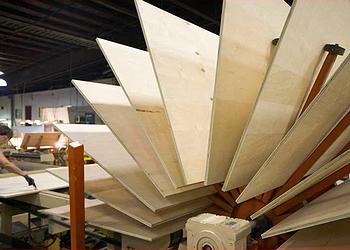
WASHINGTON, DC, May 29, 2013 (ENS) – Giving expression to a law unanimously passed by Congress in 2010, the U.S. Environmental Protection Agency today proposed two rules to help protect Americans from exposure to the harmful chemical formaldehyde emitted from wood products. These rules ensure that composite wood products, whether produced in the United States or imported, meet the formaldehyde emission standards established by that law.
At room temperature, formaldehyde is a colorless, flammable gas with a pungent smell. It is also known as methanal, methylene oxide, oxymethyline, methylaldehyde, and oxomethane. Formaldehyde is used in the production of fertilizer, paper, plywood, and urea-formaldehyde resins.

Formaldehyde is used in adhesives that make up composite building materials such as hardwood plywood, medium-density fiberboard, particleboard, and finished goods containing these products. The emitted formaldehyde can be left over from the resin or composite wood making process or be released when the resin degrades in the presence of heat and humidity. The highest potential exposure occurs when workers breathe contaminated workplace air.
Exposure to formaldehyde can cause adverse health effects including eye, nose and throat irritation, neurological symptoms, even cancer. The Department of Health and Human Services has determined that formaldehyde is a known human carcinogen based on human and animal inhalation studies.
“The proposed regulations announced today reflect EPA’s continued efforts to protect the public from exposure to harmful chemicals in their daily lives,” said James J. Jones, EPA’s acting assistant administrator for the Office of Chemical Safety and Pollution Prevention. “Once final, the rules will reduce the public’s exposure to this harmful chemical found in many products in our homes and workplaces.”
In 2010, Congress passed the Formaldehyde Standards for Composite Wood Products Act, or Title VI of the Toxic Substances Control Act, which establishes emission standards for formaldehyde from composite wood products and directs EPA to propose rules to enforce the act’s provisions.
EPA’s proposed rules align, where practical, with the requirements for composite wood products set by the California Air Resources Board, putting in place national standards for companies that manufacture or import these products.
EPA’s national rules will also encourage an ongoing industry trend towards switching to no-added formaldehyde resins in composite wood products.

EPA’s first proposed rule limits how much formaldehyde may be emitted from hardwood plywood, medium-density fiberboard, particleboard and finished goods, that are sold, supplied, offered for sale, manufactured, or imported in the United States.
This proposal also includes testing requirements, laminated product provisions, product labeling requirements, chain of custody documentation, recordkeeping, a stockpiling prohibition, and enforcement provisions.
It includes an exemption from some testing and recordkeeping requirements for products made with no added formaldehyde resins.
The second proposal establishes a third-party certification framework designed to ensure that manufacturers of composite wood products meet the Toxic Substances Control Act formaldehyde emission standards by having their composite wood products certified though an accredited third-party certifier.
This proposed third-party certification program is intended to ensure that composite wood products sold in this country meet the emission standards in the rule regardless of whether they were made in the United States or not.
More on formaldehyde proposals: http://www.epa.gov/oppt/chemtest/formaldehyde/index.html
More on EPA’s TSCA Work Plan chemical effort: http://www.epa.gov/oppt/existingchemicals/pubs/workplans.html
Copyright Environment News Service (ENS) 2013. All rights reserved.
